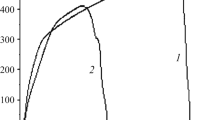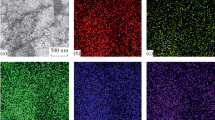A high-entropy Co – Cr – Fe – Mn – Ni alloy with a non-equiatomic composition obtained by the method of wire arc additive manufacturing (WAAM) is studied. The stress-strain curves due to tension of the alloy are analyzed in the initial condition and after electron beam treatment. The strength and ductility parameters, the nano- and microhardness, and the tribological properties are determined as a function of the energy density of the electron beam. Analysis of the fracture surface after the electron beam treatment and of the regions of ductile fracture shows the presence of a region with a banded (lamellar) structure. The scalar dislocation density is shown to vary nonmonotonically and to attain a maximum value of about 5.5 × 1010 cm – 2 at a distance of 25 µm from the irradiated surface. The electron beam treatment lowers the strength and ductility properties of the high-entropy alloy. It is assumed that the defects produced in the surface layer under such a treatment may be responsible for lowering of the strength and ductility of the alloy.





Similar content being viewed by others
References
E. P. George, W. A. Curtin, and C. C. Tasan, “High entropy alloys: A focused review of mechanical properties and deformation mechanisms,” Acta Mater., 188, 435 – 474 (2020).
V. Shivam, J. Basu, V. K. Pandey, et al., “Alloying behaviour, thermal stability and phase evolution of quinary AlCoCrFeNi high entropy alloy,” Adv. Powder Technol., 29, 2221 – 2230 (2018).
U. L. Ganesh and H. Raghavendra, “Review on the transition from conventional to muli-component-based nano-high-entropy alloys-NHEAs,” J. Therm. Anal. Calorim., 139, 207 – 216 (2020).
K. A. Osintsev, V. E. Gromov, S. V. Konovalov, et al., “HEAs: structure, mechanical properties, deformation mechanisms and application,” Izv. Vysh. Uchebn. Zaved., Chern. Metall., No. 4, 1 – 8 (2021).
V. E. Gromov, S. V. Konovalov, Yu. F. Ivanov, and K. A. Osintsev, “Structure and properties of high-entropy alloys,” Adv. Struct. Mater., 107, Springer (2021), 110 p.
Yu. F. Ivanov, V. E. Gromov, S. V. Konovalov, and Yu. A. Shlyarov, “Evolution of structure of AlCoCrFeNi high-entropy alloy under irradiation with pulsed electron beam,” Zh. Tekh. Fiz., 91(12), 1971 – 1974 (2021).
K. Osintsev, S. Konovalov, and D. Zaguliaev, “Investigation of Co – Cr – Fe – Mn – Ni non-equiatomic high-entropy alloy fabricated by wire additive manufacturing,” Metals, 12(2), 197 (2022).
K. A. Osintsev, S. V. Konovalov, V. E. Gromov, et al., “Microstructure and mechanical properties of non-equiatomic Co25.4 Cr15 Fe37.9 Mn3.5 Ni16.8 Si1.4 high-entropy alloy produced by wire-arc additive manufacturing,” Mater. Lett., 312, 131675 (2022).
T. Zhang, L. Xin, F. Wu, et al., “Microstructure and mechanical properties of Fex CoCrNiMn high-entropy alloys,” J. Mater. Sci. Technol., 35(10), 2331 – 2335 (2019).
B. A. Gludovats, A. Hohenwarter, D. Catoor, et al., “Fracture-resistant high-entropy alloy for cryogenic applications,” Science, 345(6201), 1153 – 1158 (2014).
D. I. Proskyrovsky, V. P. Rotshtein, G. E. Ozur, et al., “Physical foundations for surface treatment of materials with low energy, high current electron beams,” Surf. Coat. Technol., 125(1 – 3), 49 – 56 (2000).
S. Konovalov, Y. Ivanov, V. Gromov, and I. Panchenko, “Fatigue-induced evolution of AISI 310S steel microstructure after electron beam treatment,” Materials, 13(20), 4567 (2020).
P. Lyu, T. Peng, Y. Miao, et al., “Microstructure and properties of CoCrFeNiMo0.2 high-entropy alloy enhanced by high-current pulsed electron beam,” Surf. Coat. Technol., 410, 126911 (2021).
J. Cai, Y. Yao, C. Gao, et al., “Comparison of microstructure and oxidation behavior of NiCoCrAlYSi laser cladding coating before and after high-current pulsed electron beam modification,” J. Alloys Compd., 881, 160651 (2021).
K. Osintsev, V. Gromov, Y. Ivanov, et al., “Evolution of structure in AlCoCrFeNi high-entropy alloy irradiated by a pulsed electron beam,” Metals, 11, 1228 (2021).
N. N. Koval and Yu. F. Ivanov, “Surface nanostructuring of cermet and ceramic materials under pulsed electron beam treatment,” Izv. Vysh. Uchebn. Zaved., Fiz., No. 5, 60 – 70 (2008).
Author information
Authors and Affiliations
Additional information
Translated from Metallovedenie i Termicheskaya Obrabotka Metallov, No. 11, pp. 54 – 59, November, 2022.
Rights and permissions
Springer Nature or its licensor (e.g. a society or other partner) holds exclusive rights to this article under a publishing agreement with the author(s) or other rightsholder(s); author self-archiving of the accepted manuscript version of this article is solely governed by the terms of such publishing agreement and applicable law.
About this article
Cite this article
Shlyarova, Y.A., Gromov, V.E., Konovalov, S.V. et al. Effect of Electron Beam Treatment on the Structure, Properties and Fracture Behavior of High-Entropy Co – Cr – Fe – Mn – Ni Alloy. Met Sci Heat Treat 64, 662–667 (2023). https://doi.org/10.1007/s11041-023-00868-4
Received:
Published:
Issue Date:
DOI: https://doi.org/10.1007/s11041-023-00868-4




